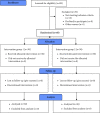The Efficacy of Manual Therapy and Pressure Biofeedback-Guided Deep Cervical Flexor Muscle Strength Training on Pain and Functional Limitations in Individuals with Cervicogenic Headaches: A Randomized Comparative Study
- PMID: 37608909
- PMCID: PMC10442171
- DOI: 10.1155/2023/1799005
The Efficacy of Manual Therapy and Pressure Biofeedback-Guided Deep Cervical Flexor Muscle Strength Training on Pain and Functional Limitations in Individuals with Cervicogenic Headaches: A Randomized Comparative Study
Abstract
Objective: This study aimed to compare the efficacy of manual therapy and pressure biofeedback-guided DCFM strength training on pain intensity and functional limitations in individuals with CGH. Trial Design. A double-blinded, two-arm parallel group randomized comparative design.
Methods: After applying the eligibility criteria, sixty out of eighty-nine CGH patients were recruited from King Saud University Medical Center in Riyadh and randomly allocated to intervention groups using simple random sampling. Group 1 underwent pressure biofeedback-guided DCFM strength training and conventional treatment, while Group 2 received manual therapy and conventional treatment for three consecutive weeks. The main outcome measures were scores on the visual analog scale (VAS) and the headache disability index (HDI). One assessor and two physical therapists were blinded to group allocation.
Results: Sixty out of eighty participants aged 29-40 years were randomized into intervention groups (n = 30/group; age (mean ± standard deviation): group 1 = 35.0 ± 2.82; group 2 = 34.87 ± 2.60), and their data were analyzed. A significant improvement (95% CI, p < 0.05) was observed within each group when comparing the VAS and HDI scores between baseline and postintervention. In contrast, between-group comparisons for the outcome score of VAS and HDI revealed nonsignificant differences in the first, second, and third weeks after intervention, except for the VAS score, which showed a significant difference in weeks 2 and 3 after intervention. Cohen's d-value indicated that the intervention effect size for reducing pain was larger in group 1 than in group 2 at weeks 2 and 3.
Conclusion: Compared with manual therapy, pressure biofeedback-guided DCFM strength training showed a greater reduction in pain intensity (assessed using the VAS) at weeks two and three. However, both treatments were equally effective in lowering headache-related functional limitations in patients with CGH. This trial is registered with ClinicalTrial.gov PRS (Identifier ID: NCT05692232).
Copyright © 2023 Shahnaz Hasan et al.
Conflict of interest statement
The authors declare that there are no conflicts of interest.
Figures




Similar articles
-
Manual treatment for cervicogenic headache and active trigger point in the sternocleidomastoid muscle: a pilot randomized clinical trial.J Manipulative Physiol Ther. 2013 Sep;36(7):403-11. doi: 10.1016/j.jmpt.2013.05.022. Epub 2013 Jul 8. J Manipulative Physiol Ther. 2013. PMID: 23845200 Clinical Trial.
-
Effectiveness of Mulligan manual therapy over exercise on headache frequency, intensity and disability for patients with migraine, tension-type headache and cervicogenic headache - a protocol of a pragmatic randomized controlled trial.BMC Musculoskelet Disord. 2021 Mar 3;22(1):243. doi: 10.1186/s12891-021-04105-y. BMC Musculoskelet Disord. 2021. PMID: 33657998 Free PMC article.
-
An Additive Effect of Instrument-Assisted Soft Tissue Mobilization with Spinal Manipulation in Cervicogenic Headache: a Randomized Controlled Trial.Pain Ther. 2024 Dec;13(6):1679-1693. doi: 10.1007/s40122-024-00671-w. Epub 2024 Oct 28. Pain Ther. 2024. PMID: 39467979 Free PMC article.
-
The Effectiveness of Intraarticular Cervical Facet Steroid Injections in the Treatment of Cervicogenic Headache: Systematic Review and Meta-analysis.Pain Physician. 2022 Sep;25(6):459-470. Pain Physician. 2022. PMID: 36122255
-
Comparative safety and efficacy of manual therapy interventions for cervicogenic headache: a systematic review and network meta-analysis.Front Neurol. 2025 May 16;16:1566764. doi: 10.3389/fneur.2025.1566764. eCollection 2025. Front Neurol. 2025. PMID: 40452767 Free PMC article.
References
-
- Biondi D. M. Cervicogenic headache: a review of diagnostic and treatment strategies. Journal of the American Osteopathic Association . 2005;105(4 Suppl 2):16–22. - PubMed
-
- Shahid A., Shahzad T., Zaheer M., et al. Cervicogenic headache: diagnostic evaluation and outcomes of various physiotherapy modes. Annals of Medical and Health Sciences Research . 2022;15
Publication types
MeSH terms
Associated data
LinkOut - more resources
Full Text Sources
Medical

